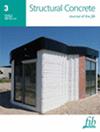高范围减水剂和 W/C 比对纤维增强天然沸石 SCC 的新鲜度和力学性能的影响
IF 3.3
3区 工程技术
Q2 CONSTRUCTION & BUILDING TECHNOLOGY
引用次数: 0
摘要
本研究旨在探讨在考虑不同比例的聚丙烯纤维(PF)和天然沸石(NZ)的情况下,高程减水剂(HRWR)的使用和水灰比(W/C)的变化如何影响自密实混凝土(SCC)的性能。共浇注和分析了 28 个样品。按重量计,聚丙烯纤维的添加量从 0% 到 1.5%,同时用 10% 的天然沸石替代水泥(50 千克/立方米)。除了 5 至 6.5 公斤/立方米的七种 HRWR 含量外,还测试了四种 W/C(0.30、0.35、0.40 和 0.45)比率。进行了各种测试,以评估坍落度、T500、V 型隧道、L 型箱、弹性模量以及抗压、抗拉和抗弯强度。根据 W/C、HRWR、PF 和 NZ 含量,开发了预测硬化混凝土性能的新模型。研究结果表明,当 PF 含量高达 0.75%、HRWR 含量相当于水泥组分和 NZ 比率的 1.25%时,使用 NZ 的 PF 增强 SCC 可达到最佳性能。此外,根据 W/C 和 HRWR 比率,所提出的模型还能准确预测采用 NZ 的 PF 加固 SCC 的新鲜状态和硬化状态性能。本文章由计算机程序翻译,如有差异,请以英文原文为准。
Effect of high‐range water reducer and W/C ratio on the fresh and mechanical properties of fiber‐reinforced natural zeolite SCC
The present study aims to investigate how the use of high‐range water reducer (HRWR) and variations in water/cement (W/C) ratio affect the properties of self‐consolidating concrete (SCC) while taking into account different proportions of polypropylene fibers (PF) and natural zeolite (NZ). A total of 28 samples were cast and analyzed. PF fractions ranging from 0% to 1.5% by weight were added, along with a substitution of 10% NZ for cement (50 kg/m3 ). Four W/C ratios (0.30, 0.35, 0.40, and 0.45) were tested, in addition to seven HRWR contents ranging from 5 to 6.5 kg/m3 . Various tests were conducted to assess slump, T500 , V‐funnel, L‐box, modulus of elasticity, and compressive, tensile, and flexural strengths. Novel models were developed to predict the properties of hardened concrete based on W/C, HRWR, PF, and NZ content. Findings indicated that optimal performance of PF‐reinforced SCC with NZ was achieved when up to 0.75% PF was combined with an HRWR content equivalent to 1.25% of the cement fraction and NZ ratio. Furthermore, the proposed models offer accurate predictions of both fresh and hardened‐state properties of PF‐reinforced SCC with NZ based on W/C and HRWR ratios.
求助全文
通过发布文献求助,成功后即可免费获取论文全文。
去求助
来源期刊

Structural Concrete
CONSTRUCTION & BUILDING TECHNOLOGY-ENGINEERING, CIVIL
CiteScore
5.60
自引率
15.60%
发文量
284
审稿时长
3 months
期刊介绍:
Structural Concrete, the official journal of the fib, provides conceptual and procedural guidance in the field of concrete construction, and features peer-reviewed papers, keynote research and industry news covering all aspects of the design, construction, performance in service and demolition of concrete structures.
Main topics:
design, construction, performance in service, conservation (assessment, maintenance, strengthening) and demolition of concrete structures
research about the behaviour of concrete structures
development of design methods
fib Model Code
sustainability of concrete structures.
 求助内容:
求助内容: 应助结果提醒方式:
应助结果提醒方式:


